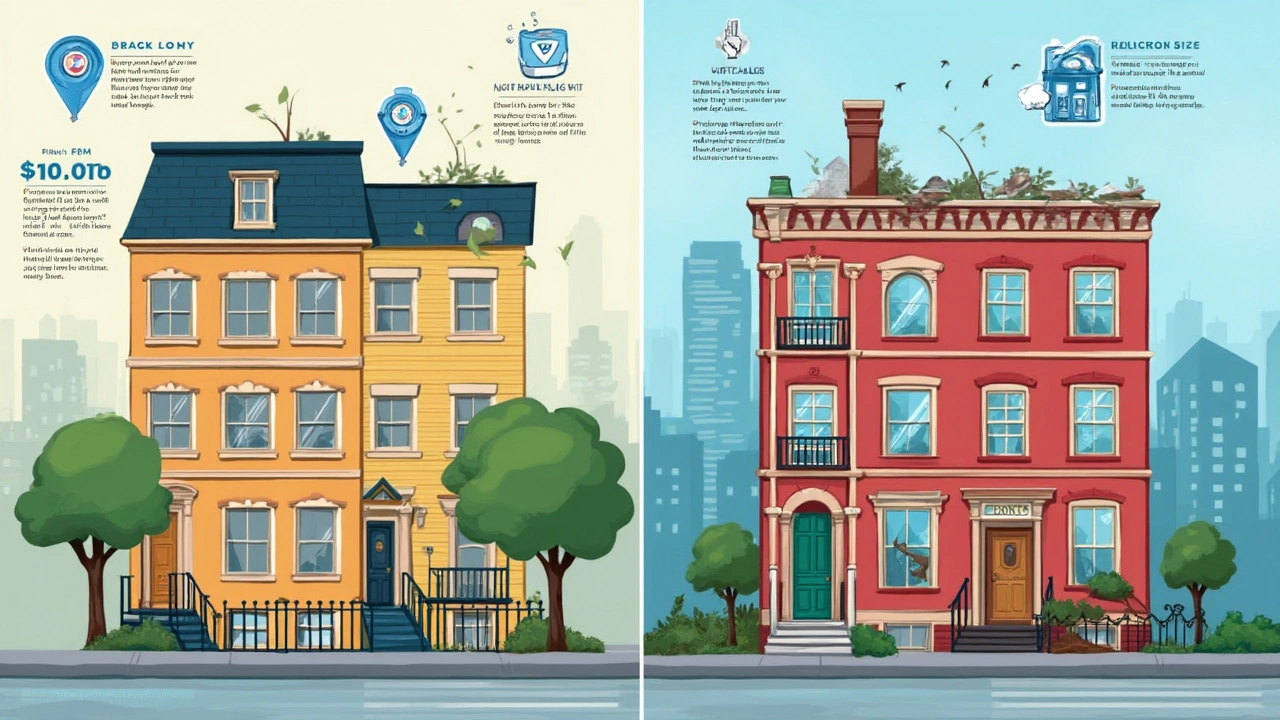The Building Blocks of Real Estate Valuation
If you’ve ever scrolled through Zillow and wondered why two almost identical houses six blocks apart have totally different prices, that’s real estate valuation at work. This isn’t about plucking a number from thin air. There’s a complex but logical foundation behind each digit, designed to answer one question: What would someone really pay for this property today? What surprises people is that the answer isn’t just about the building—it’s also about everything swirling around it.
First things first. There are three main ways appraisers get to a number. The Sales Comparison Approach looks at similar properties (called "comps") that sold recently. If you're sizing up a two-bedroom in Brooklyn and another sold a block away last month, that price sets a baseline. Next up, the Cost Approach figures out what it would cost to rebuild the place from scratch, and then subtracts how much it's aged or worn out. Picture this like pricing out a custom Lego set, then deducting for missing pieces. The Income Approach, mostly for apartments or investment buildings, checks what the property could earn as rent and uses a multiplier to value it.
For regular folks, the Sales Comparison is king. But here’s the twist: Even within New York, comps can be slippery. Two apartments, both with 900 square feet and two bedrooms, can have totally different vibes (think: lighting, layout, views, or even neighbor vibes). Sometimes, a ratty but sunny place fetches more than a swanky but dungeon-dark unit. Condition, location within the building, even pet policies or elevator access, can move prices in ways outsiders would never think about.
Here's something wild: A 2022 study showed that simply having newer kitchen appliances boosted seller returns by an average of $2,500, and smart home tech (like a Nest thermostat) added another $1,300 in urban markets. Small features, big money. The process gets even trickier in uncertain markets. During COVID-19, the lack of in-person viewings caused some classic pricing methods to stumble, as emotional appeal—the scent of cookies, the sound of city traffic—got lost in virtual walk-throughs. If you’re thinking algorithms have it all covered now, think again. Automated Valuation Models (AVMs), like those used by Redfin, get you in the ballpark. But if a neighbor secretly renovates with high-end marble everywhere, that algorithm won’t catch the bling, and human appraisers still have the edge.
What Makes or Breaks a Property’s Value?
You’d think square footage alone would decide a home’s worth—but New York will teach you otherwise. Sometimes, the tiniest detail can swing a deal by thousands. Got a killer balcony view? That can outshine an extra closet. Or maybe there's a laundry room on every floor—huge for city dwellers tired of laundromats. Everyone assumes location is king, but there’s more: The local school zone can add serious cash to a home, even for buyers who don’t have kids. In 2023, homes in top-rated school zones in Manhattan averaged $320,000 higher prices compared to similar ones just out of bounds. That’s not loose change.
Timing plays a gigantic role too. In spring, inventory jumps and so do prices. By winter, buyers hold out for deals, so even great apartments might languish, forcing prices down. Sometimes sellers get starry-eyed if a neighbor’s home sold for a record high, then wonder why theirs is stuck. Here’s the truth: Market shifts happen fast. In April 2024, Manhattan saw the median sale price drop by 4% in just six weeks thanks to a spike in new listings and rising interest rates.
Condition is massive. You can call it ‘well-loved’ all you want—if the floors creak and there’s avocado green tile, buyers will cut their offers. The little fixes matter: fresh paint, replaced hardware, or decluttered spaces turn up way more offers. Upgrades don’t need to be luxury. HGTV did a rundown last year showing that modest updates like new bathroom fixtures or energy-efficient lights returned nearly twice their cost at sale. If you’re playing the DIY game, remember that bad handiwork (think: visible caulk blobs or uneven paint) actually scares buyers off more than older finishes done right.

How Professionals (And Amateurs) Get It Wrong
Appraisers walk a tightrope. They use formulas and recent sales, but in real life, the tiniest things shake up those numbers—like a noisy bar opening downstairs, or a hidden garden suddenly blooming in the backyard. There are stories from 2023 where a Brooklyn townhouse saw its value drop $100,000 after a new rooftop club next door kept buyers up at night. If a buyer offers all cash, some sellers just jump at that and ignore the appraised value. Or if a bidding war erupts (crazy, but it keeps happening in certain pockets), winning offers can sit way above the mathematical 'correct' price. These bubbles pop sometimes, and the record sale one month becomes the cautionary tale the next.
Even pros screw it up with bias. Studies show that appraisers sometimes unconsciously tweak numbers based on the client's expectation, or neighborhood stereotypes. A 2021 Harvard study found homes owned by Black families in majority-white neighborhoods appraised for about 15% less, even when their features matched neighboring houses. The industry is fighting this, but it’s slow going.
Technology, as cool as it sounds, can miss the human story. Zillow’s “Zestimate” has been off by as much as 7.5% in high-rise Manhattan condos, especially when interior renovations fly under the radar or a unit’s unique quirk isn’t logged—like the time a celebrity’s penthouse was “valued” nearly a million dollars less than it eventually sold for, all because someone failed to note the private rooftop deck.
Valuation Tricks for Buyers, Sellers, and Investors
So, you want to sniff out if a price makes sense, or get top dollar selling yours? Start with the comps, but dig deeper. Don’t just check the “recent sales”—go see them if possible, or ask to see listing photos. Notice what those sellers did with lighting, flooring, even the way they staged the living room. If their place felt “open” and yours is filled with oversized furniture, that vibe costs you.
Tour the open houses in your target area and jot down details. The more you see, the more you can spot pricing traps or opportunities. Truth is, buyers still love staged homes, but they're also wary of cover-ups. A subtle patch in the wall or a strong scented candle makes people think someone’s hiding leaks or bad smells. Be upfront if you’re selling—full disclosure tends to win trust, which can boost offers above asking.
- Buyers: Always read the fine print on maintenance fees if you’re looking at co-ops or condos. An apartment with a $1,000 monthly maintenance might actually cost more than a pricier place with $400 fees.
- Sellers: Don’t price high thinking “let’s see what happens.” Overpriced homes sit, and then buyers wonder what’s wrong when you drop the price. Better to land a tad below market—bidding wars are more likely that way.
- Investors: Learn the rental demand cold. If rents are dropping, rethink. Rental yield calculators seem dry, but one tiny move in local vacancy rates can flip a building from goldmine to money pit.
- Everyone: Get a second opinion if something feels off. A “lowball” offer can sometimes be your best friend if you see a hidden flaw others missed, making for a solid negotiation point.
Curious about how upgrades can turn into value? There’s a real trick in not just gut-renovating, but noticing what buyers crave in that neighborhood. In some parts of Queens, open kitchens are the rage; in others, people want pocket doors or soaking tubs. The right $5,000 tweak can add $15,000 in perceived value if you nail what locals want.

Fast Facts, Odd Stories, and Market Data
Did you know that in New York’s ultra-luxury market, parking spots have sold for $300,000? And in some cases, a deeded storage unit can raise a condo’s price more than central A/C. There’s a property in Tribeca that moved at nearly $500,000 over asking—all because a famous designer once lived there, and buyers bid for the bragging rights.
| Feature | Average Value Added (NYC, 2023) |
|---|---|
| Washer/Dryer in Unit | $8,200 |
| Private Outdoor Space | $16,000 |
| Central HVAC vs. Window Units | $9,800 |
| Close to Subway (<0.3 mile) | $11,500 |
Pandemic made a few things go sideways, too. In 2021, some Manhattan owners of high-rise studios fired their agents and listed their own places, offering a year’s worth of HOA fees paid upfront. Units moved 12% faster even in a sluggish climate—that’s a marketing lesson and a half.
Valuations aren’t just about now—they predict the ripple effects of new schools, subway extensions, or migration trends. Empty office blocks in Midtown turn into apartments? You can bet the first wave of buyers scoops big deals, and the second wave pays the new normal.
If you still think “my place is special,” remember: Only 14% of homes sell for more than the professional appraisal in buyers’ markets, but 37% do in hot ones, like Brooklyn in 2021. Where you fall depends on luck, smarts, and what you do with this knowledge.

10 Responses
Really intrigued by the way the article demystifies the valuation process. Having always wondered how pros price houses, it’s enlightening to see the structural breakdown focusing on local market factors like those in New York.
One thing that caught my eye was the emphasis on quirky facts—those add flavor and context beyond dry numbers. It makes me think about how external perceptions and emotional appeal can sometimes influence price estimates more than we realize.
Also, the discussion about common appraisal errors was quite revealing. It makes me cautious about taking any single valuation at face value without considering potential oversights or misjudgments by appraisers.
Does anyone have experience dealing with these valuation pitfalls firsthand? How did you negotiate when you suspected a property's value was skewed?
Overall, this piece provides a solid foundation for anyone diving into real estate, whether buying or selling.
While I appreciate the article's attempt to simplify a complex subject, I find its treatment somewhat superficial. Real estate valuation is an intricate discipline that defies neat categorization into a series of tips and quirky facts.
A truly comprehensive analysis would entail detailed exploration of market trends, zoning laws, and economic indicators, none of which receive adequate attention here. As it stands, the guidance appears generic, offering little beyond what one might glean from a casual browse of a property listing.
Moreover, the reliance on New York's market as a case study, while interesting, limits the article's applicability globally.
I would have preferred a more rigorous, data-driven discourse rather than light anecdotes that risk misleading the reader about valuation’s true complexity.
Nonetheless, for newcomers, perhaps this serves as a passable introduction.
I really liked how the article breaks things down for people who are totally new to real estate. Sometimes these topics get way too complicated, but this kept it simple and easy to follow :)
One part that stood out was the advice for buyers and sellers—those little nuggets of practical tips make a huge difference when you’re trying to navigate pricing without feeling overwhelmed.
Also, taking a moment to explain those odd mistakes that can wrong-foot valuations was a smart move. It’s important to be aware of what might cause a price to feel off, even if you don’t fully understand the technical stuff behind it.
Would love to hear about others’ experiences—have you ever walked away from a deal because something about the valuation didn’t sit right?
This article is SUCH a rollercoaster of feelings! Like, real estate valuation can be a big, scary topic, but here it’s almost like a thrilling mystery where you learn the secrets bit by bit.
Seriously, the quirky facts about New York? That’s the kind of thing that gets me hooked, reading about how neighborhoods can totally flip the script on a price tag.
But also, the mistakes part? Like, who hasn’t had that sinking feeling when you realize maybe the value wasn’t what you thought? It’s a little heartbreaker moment.
Honestly, I wish the article had even more stories from real people who got stuck in these valuation traps because that human element is what really sells the drama!
Anyway, big thanks for giving us this peek behind the curtain—felt like a mini soap opera about property prices 😄
Ah yes, the supposedly "straightforward" advice — as if pricing hundreds of thousands to millions of dollars in property could be distilled into a few tips and anecdotes without losing every bit of nuance.
While the article tries to charm us with quirky tidbits, the real danger lies in oversimplification. For example, what about the hidden influence of unseen investors, or how appraisers sometimes operate under pressure from interested parties?
Also, the New York market is notoriously volatile, and any examples drawn from there must be scrutinized carefully. I’m skeptical about the reliability of ‘real-world examples’ that don’t discuss the political economy of urban real estate.
Much as I appreciate enthusiasm for enlightening readers, beware the allure of surface-level explanations when dealing with such consequential financial decisions. There's more happening behind the scenes than meets the eye.
Great breakdown on the valuation processes! What I appreciate most is how the article stresses that both buyers and sellers can benefit from understanding what goes into pricing. Knowledge can really bridge that gap and help with negotiations.
One thing I’d add from my own experience is the importance of local context. The article touches on New York, but whether you’re in a big city or a small town, nuances matter. The comparables, market demand, neighborhood trends—all this shapes the final number.
Also, I agree with the point about appraisal mistakes. Sometimes these aren’t just innocent errors—they can be due to outdated assessments or a lack of thorough investigation.
Overall, I think the article empowers readers quite well, encouraging them to ask the right questions instead of just trusting the first price they hear.
This is a nice little introduction, I suppose. It’s quite casual and doesn’t dive too deep, which for some could be a plus if you want a quick read to get familiar with real estate valuation terms and tricks.
I liked that it didn’t overwhelm with jargon, so you can actually stick with the narrative. But personally, I do wish it had more perspective on how emotional factors—like buyer sentiment—play into pricing because numbers alone rarely tell the whole story.
As someone who’s watched the market morph considerably, I’m curious how these methods hold up in a fluctuating economy? Does anyone know if the approaches outlined are adaptable in recession or boom times?
Meh. The article is alright, maybe a bit basic for those who’ve peeked at property pricing before. It’s kind of what I expected—nothing groundbreaking.
For people who actually want to get into the nitty-gritty, this probably isn’t enough. But I guess for newbies it might serve as a decent starting point. Just don’t expect mind-blowing secrets or insider scoop.
That said, it did make me wonder if any of you have used different valuation methods and gotten wildly different results? I’d be curious about how consistent these pricing approaches really are across different markets.
Oh, absolutely. The real estate valuation game is much more convoluted than any article willing to simplify it dares to admit. There’s always an unseen hand influencing what the final ‘estimated price’ ends up being.
I suspect behind the so-called quirky facts and friendly advice lie opaque dealings between appraisers, agents, and even corporate interests that shape market prices quietly.
So whenever you’re told a home is valued a certain way, ask yourself: Who benefits from that number? Because the truth is hardly ever neutral or purely objective.
I appreciate that the article helps people start asking questions—but remember, in real estate, questions often lead to more questions and fewer honest answers.
@51 Yeah, I totally relate! Being new to this stuff, any insight that helps decode what those pricing numbers actually mean is gold. 🙂
And yes, hearing real stories about when valuations didn’t add up would be super helpful. It could help future buyers or sellers avoid costly mistakes.
I think the mention of weird mistakes was cool because it reminds us that even experts aren’t perfect—so trust but verify, right?